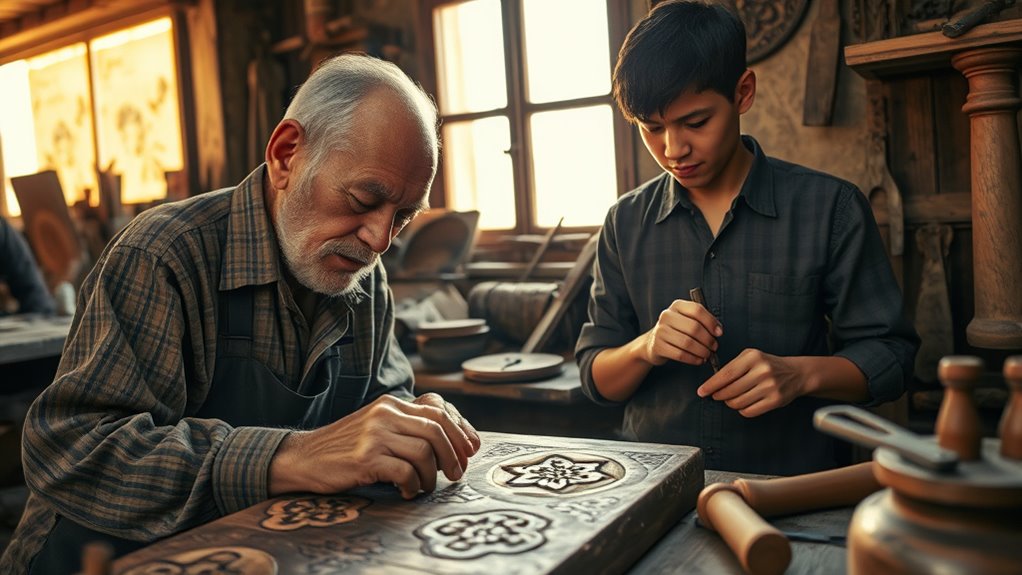You’ll find humans excel in creativity, emotional insight, and ethical judgment—areas where AI still falls short. Your ability to imagine, innovate, and develop unique perspectives fuels art, design, and storytelling with authentic cultural depth. You naturally build genuine connections through empathy and emotional intelligence, especially in education and counseling. Resilience and adaptability help you navigate rapid change and moral dilemmas. Keep exploring to discover what truly sets humans apart and how your skills remain essential.
Key Takeaways
- Humans excel in creative thinking, innovation, and developing long-term visions that require intrinsic motivation and cultural nuance.
- Emotional intelligence enables humans to understand, interpret, and respond to complex social and cultural contexts effectively.
- Human judgment incorporates empathy, ethics, and social awareness, allowing nuanced decision-making in ambiguous or morally complex situations.
- Personal experiences and cultural backgrounds foster authentic, relatable connections that AI cannot replicate.
- Humans can adapt creatively and intuitively to evolving social dynamics, symbolism, humor, and emotional nuances.
The Power of Imagination and Innovation in Human Creativity

Imagination and innovation are at the core of human creativity, fueling ideas that often surpass what technology alone can achieve. You’re driven by intrinsic motivation, which sparks groundbreaking concepts from within. Your ability to incorporate rich cultural nuances makes your work emotionally resonant and relatable. Human creativity unfolds through both unconscious “aha” moments and deliberate, conscious efforts—called Type 1 and Type 2 processes—allowing for spontaneous insight and careful refinement. Emotional intelligence plays a crucial role, helping you craft stories and designs that inspire empathy and resilience. Long-term vision and dedication, like Cameron’s work on *Avatar*, show how humans can pursue innovative projects over years. This blend of intuition, culture, and perseverance keeps human creativity uniquely powerful and capable of shaping the future. The Significance of Creative Thinking The Future of Jobs Report 2023 emphasizes analytical and creative thinking as key skills. Additionally, protective styling benefits demonstrate how human ingenuity adapts traditional techniques for modern expression, further highlighting the unique capacity for innovation. Recognizing the importance of cultural nuances enhances our understanding of how diverse perspectives contribute to creative excellence, especially when combined with innovative problem-solving techniques. Moreover, cultivating a mindset of curiosity can significantly expand the horizons of human imagination, leading to even more groundbreaking ideas. Incorporating performance metrics can also help individuals and organizations refine their creative processes and achieve sustained success.
Cultural Sensitivity and Emotional Nuance in Design and Art

You need to recognize that true cultural depth and context elevate design and art beyond surface-level visuals. Creating emotional connections requires understanding nuanced cultural expressions and avoiding stereotypes. When you focus on these elements, your work resonates more authentically with diverse audiences. AI’s limitations in grasping cultural nuances highlight the importance of human insight in capturing authentic emotional and cultural resonance. Additionally, incorporating sustainable materials and ethical sourcing can further deepen the cultural significance and respect for diverse traditions in creative work. Recognizing the importance of water-inspired themes in cultural art can also help evoke genuine emotional responses and foster meaningful connections. Incorporating authentic decor elements rooted in cultural traditions can further enrich the emotional depth of your work. Understanding the cultural symbolism behind various motifs can help ensure your work remains respectful and meaningful. Emphasizing offensive security measures in design can help protect cultural content from misuse or misappropriation.
Cultural Depth and Context
How well can AI truly grasp the depth of cultural sensitivity and emotional nuance in design and art? AI often misses the core values and beliefs that shape a culture, producing responses that feel disconnected or superficial. It tends to reinforce stereotypes, sometimes even harmful ones, because it lacks a nuanced understanding of cultural complexity. Subtle expressions like humor, idioms, or sarcasm are frequently misapplied, leading to misrepresentation or offense. Cultures are dynamic, evolving entities, yet AI struggles to keep pace with these changes. Human insight, rooted in lived experience and emotional intelligence, remains essential to authentically interpret and embed cultural depth. Recognizing the importance of cultural context can help mitigate these issues, but AI’s grasp of such nuances remains limited. Additionally, AI’s inability to continuously adapt to cultural evolution means that responses may become outdated or misaligned over time. Recent evaluations further highlight these limitations, emphasizing that AI’s grasp of cultural nuance remains inadequate. Without cultural awareness, even sophisticated algorithms risk producing content that is tone-deaf or inappropriate, underscoring the enduring value of human empathy and understanding in creative fields. Furthermore, AI’s tendency to generate generic responses can diminish the richness of cultural expression, which is vital for authentic representation. Moreover, global economic trends influence cultural shifts, making it even more challenging for AI to stay current with evolving cultural narratives.
Emotional Connection Creation
Creating genuine emotional connections through design and art requires sensitivity to cultural nuances that AI often struggles to grasp. You need to understand the subtle cues that evoke feelings, such as color choices, symbols, and storytelling styles, which vary widely across cultures. When you craft experiences that resonate emotionally, you tap into shared human values and personal histories. Visualize a scene where:
- An artist captures the soulful expression of a face, revealing deep emotion.
- A design incorporates symbols meaningful to a specific community.
- An artwork tells a story that evokes nostalgia and empathy.
- A user interface adapts seamlessly to cultural preferences, fostering trust.
Additionally, understanding Dog breeds can inform personalized and culturally sensitive design choices, enhancing connection and empathy with diverse audiences. Recognizing the importance of natural materials in Waldorf toys, for instance, can deepen emotional resonance by connecting users to a sense of authenticity and tradition. Deepening emotional engagement also benefits from an awareness of auditory processing, as sound cues and music can evoke specific feelings and cultural associations that enhance the overall experience. Incorporating sound design principles, such as ambient sounds or tailored audio cues, further enriches the emotional landscape, making interactions more relatable and impactful.
Personal Connection and Emotional Support in Education

You play a crucial role in building trust and connecting emotionally with your students. When you provide guidance and listen genuinely, you help them feel safe and understood. These personal connections are essential for fostering a positive learning environment and supporting their well-being. Social-emotional learning (SEL) helps students develop skills like empathy and emotional awareness that are vital for their overall success.
Building Trusting Relationships
Building trusting relationships in education hinges on genuine personal connections and emotional support. You rely on your authenticity, consistent interactions, and sincere concern to foster trust with students. This trust enables you to serve as a mentor, offering nuanced guidance tailored to each individual’s needs. When students feel emotionally safe, they’re more engaged, motivated, and willing to take academic risks. Your ability to observe behavioral changes, emotional distress, and social challenges firsthand allows for early intervention. You understand cultural and contextual factors, adapting your approach accordingly. Imagine:
- Sitting beside a student during a difficult moment, offering reassurance
- Recognizing subtle cues like body language or tone shifts
- Building rapport through shared experiences and genuine care
- Creating a safe space where students feel truly heard and supported
Providing Emotional Guidance
Establishing trusting relationships in education naturally leads to opportunities for providing emotional guidance, where genuine personal connections and ongoing support make a meaningful difference. As a teacher, you’re often the first to notice emotional distress or behavioral changes in students. With 80% reporting increased issues, your attentive observation can lead to early intervention, helping students before problems worsen. School-based professionals like counselors and social workers play crucial roles, but resource gaps limit their reach. Social and emotional learning (SEL) programs profoundly boost student well-being, teaching coping skills and emotional regulation. When students feel supported, they’re more engaged and resilient. Meta-analysis of over 424 experimental studies across more than 50 countries reinforces the importance of SEL in fostering a safe, inclusive environment. Despite challenges, your ability to offer emotional guidance remains essential, helping mitigate external stressors and fostering a safe, supportive school environment that promotes both academic success and emotional health.
Ethical Judgment and Moral Decision-Making

Human ethical judgment is distinguished by its ability to incorporate emotional nuance, empathy, and complex social understanding, elements that AI currently cannot fully replicate. You sense the subtle social cues, cultural backgrounds, and personal histories that shape moral decisions. Your flexibility allows you to steer through new moral dilemmas and resolve conflicts between competing values. You consider implicit social dynamics, power structures, and emotional states that influence choices.
- Steering through conflicting cultural norms with sensitivity
- Weighing emotional impacts in difficult decisions
- Adapting ethics to unfamiliar, ambiguous situations
- Recognizing unspoken social cues that influence judgments
Developing Unique Perspectives and Original Ideas

You generate original ideas by weaving your personal experiences and cultural background into your thinking. This process allows you to see connections others might miss and develop perspectives that feel authentic. By actively cultivating your cultural context, you keep your ideas fresh and uniquely yours.
Cultivating Cultural Context
How can creators craft content that truly resonates across diverse cultures? You need to harness cultural nuances and emotional intelligence that AI can’t grasp. Your ability to interpret symbols, references, and subtle differences allows you to create authentic, relatable stories. Emotions deeply influence decision-making and problem-solving, giving your work emotional depth that AI lacks. By blending personal experiences, cultural context, and imagination, you develop original ideas that stand out. Your understanding of complex social dynamics helps you craft narratives tailored to specific communities. This cultural sensitivity enables you to evoke empathy and resilience, making your content impactful across borders.
- Visualize vibrant traditions woven into modern stories
- Imagine nuanced symbols that speak to specific communities
- See emotional expressions sparking genuine connections
- Picture unique perspectives blending past and present
Fostering Personal Experiences
Ever wonder what fuels truly original ideas? It’s your ability to combine unconscious insights with deliberate thinking, creating perspectives that go beyond simple pattern recognition. Your creative process involves four stages: gathering diverse inspirations, letting ideas incubate subconsciously, experiencing sudden moments of insight, and refining those thoughts into something meaningful. These steps enable you to embed emotional and contextual nuances into your work—elements AI struggles to replicate. Your personal experiences, shaped by emotions, memories, and social interactions, influence your unique perspectives. Unlike AI, which recombines existing data, you invent new ideas by making unpredictable connections rooted in your life story. This depth of emotional and contextual understanding fuels originality, giving your work a personal resonance that’s impossible for machines to authentically emulate.
Navigating Complex Social Interactions and Conflict Resolution

Managing complex social interactions and resolving conflicts require more than just following set procedures; it demands a deep understanding of human emotions, nonverbal cues, and cultural nuances. You instinctively sense subtle feelings through body language, vocal tone, and pauses, adjusting your approach in real time. Your empathy builds trust, while cultural awareness prevents misunderstandings. During conflicts, you offer emotional support and craft creative solutions tailored to the situation. You can:
- Read facial expressions and gestures to gauge true feelings
- Use silence strategically to influence negotiations
- Mirror body language to foster rapport
- Adapt communication styles based on emotional cues
This nuanced perception gives you a distinct advantage in steering social complexities, a skill AI struggles to replicate. Your ability to connect, understand, and mediate keeps human interactions rich and genuine.
Tailoring Learning Experiences to Individual Needs

Building on the importance of understanding individual emotions and social cues, tailoring learning experiences directly addresses the unique needs of each student. Personalized learning boosts math scores by 8 and reading by 9 percentile points annually, showing it really makes a difference. It also increases motivation—75% of students feel more driven, compared to just 30% in traditional settings. Schools adopting personalized approaches see a 12% rise in attendance and a 15% drop in dropout rates. Long-term, students are more likely to complete courses—up 70% compared to standard methods. AI plays a key role by customizing content based on algorithms, further enhancing learning. This personalized focus helps you, as a learner, stay engaged, motivated, and successful in ways that generic education can’t match.
Empathy and Emotional Intelligence in Counseling and Therapy

Empathy and emotional intelligence are essential components in counseling and therapy, as they directly influence the quality of the therapeutic relationship. When you develop cognitive empathy, you better understand clients’ emotions and motivations, building trust and safety. Higher emotional intelligence enhances both cognitive and affective empathy, allowing you to connect deeply with clients. Visualize a therapist listening attentively, sensing unspoken feelings, or guiding clients through self-reflection in a safe space. These skills foster:
- Trust and understanding in sessions
- Insight into clients’ emotional states
- Better therapeutic outcomes
- Reduced counselor stress through emotional regulation
Adapting to Rapid Changes With Resilience and Flexibility

In today’s fast-paced world, adapting to rapid changes requires more than just awareness; it demands resilience and flexibility at every level of your organization. With 75% of employees reporting low mood and 74% feeling anxiety from global events, workplace stress is at an all-time high. Clear, adaptive communication becomes essential—only 47% experience transparency, yet it’s crucial for building trust and reducing anxiety. Proactive mental health support is increasingly important, as behavioral health claims rise and organizations shift toward tailored, data-driven solutions. Despite these challenges, 69% of employees remain confident in their organization’s success, highlighting the power of resilience. To thrive, you must foster flexibility, promote open communication, and implement customized strategies that support mental well-being and adaptability amidst constant change.
Cultivating Cultural and Social Contexts in Creative Projects

Understanding cultural and social contexts is essential for creating authentic and meaningful projects. You instinctively weave deep cultural knowledge and social nuances into your work, avoiding the pitfalls AI might stumble over. Culture shapes how your audience perceives and responds to your creative output, so you tailor your projects to fit specific social settings. Social dynamics, like group norms and emotional currents, influence collaboration and storytelling authenticity. You interpret symbolism, irony, and humor within cultural frameworks, recognizing their subtle, layered meanings. Awareness of historical and socio-political factors helps you craft content that resonates ethically and emotionally, fostering genuine connections.
- Visualize a mural reflecting vibrant cultural traditions.
- Imagine a story that captures shared emotional experiences.
- Envision a project infused with layered symbolism understood locally.
- Picture collaborating seamlessly within diverse social groups.
Frequently Asked Questions
How Can Humans Leverage Intuition in Decision-Making Beyond AI Capabilities?
You can leverage your intuition in decision-making by drawing on your extensive experience and emotional intelligence to navigate complex, unpredictable situations. Trust your ability to understand nuanced contexts and incorporate ethical considerations that AI might overlook. Use intuition to generate creative solutions and assess scenarios holistically, especially when data is limited or ambiguous. Combining this skill with analytical tools enhances your overall decision-making, making it more adaptable and human-centric.
What Are the Future Roles of Humans in Creative Innovation and Artistic Originality?
You’ll continue to drive creative innovation and originality by leveraging your unique perspective, emotional depth, and ethical judgment. While AI can generate ideas and assist, your ability to synthesize diverse influences, connect ideas across disciplines, and infuse work with authentic experiences remains unmatched. Your role will focus on shaping artistic visions, making nuanced decisions, and maintaining the human touch that gives creative work genuine meaning and cultural relevance.
How Does Human Empathy Enhance Client Relationships Compared to AI Interactions?
You find that human empathy substantially enhances client relationships because it shows genuine care and emotional investment, creating trust and rapport. Unlike AI, which simulates empathy without true feeling, humans provide authentic concern, understanding, and emotional support. This sincerity makes clients feel valued and understood, strengthening your connection. Your ability to share emotions and demonstrate real compassion fosters deeper loyalty, making your relationships more meaningful and resilient over time.
In What Ways Can Humans Address Ethical Dilemmas That AI Cannot Resolve?
You can address ethical dilemmas AI struggles with by relying on your emotional insight and moral judgment. While AI lacks empathy and contextual understanding, you interpret nuanced social norms and conflicting values. Your ability to reflect on consequences, consider subjective experiences, and adapt to complex human situations guarantees responsible decision-making. Trust your moral intuition, engage in dialogue, and recognize that human compassion and conscience are irreplaceable in resolving moral conflicts.
How Do Humans Develop Cultural Sensitivity That AI Systems Struggle to Understand?
You develop cultural sensitivity through real-life interactions and personal experiences. By engaging with diverse communities, you learn to understand subtle nuances like humor, idioms, and traditions. Your emotional intelligence helps you adapt to various social contexts, fostering empathy and deeper understanding. Unlike AI, your ability to interpret complex social cues and learn from ongoing experiences allows you to navigate cultural differences with nuance and sensitivity.
Conclusion
While AI can process data and replicate patterns, it can’t match your imagination or emotional depth. You bring unique perspectives, cultural understanding, and moral judgment that no algorithm can replicate. In a world driven by technology, your ability to connect, innovate, and adapt remains irreplaceable. Remember, it’s not just about what AI can do, but what you do better—your humanity, creativity, and resilience that truly set you apart.









